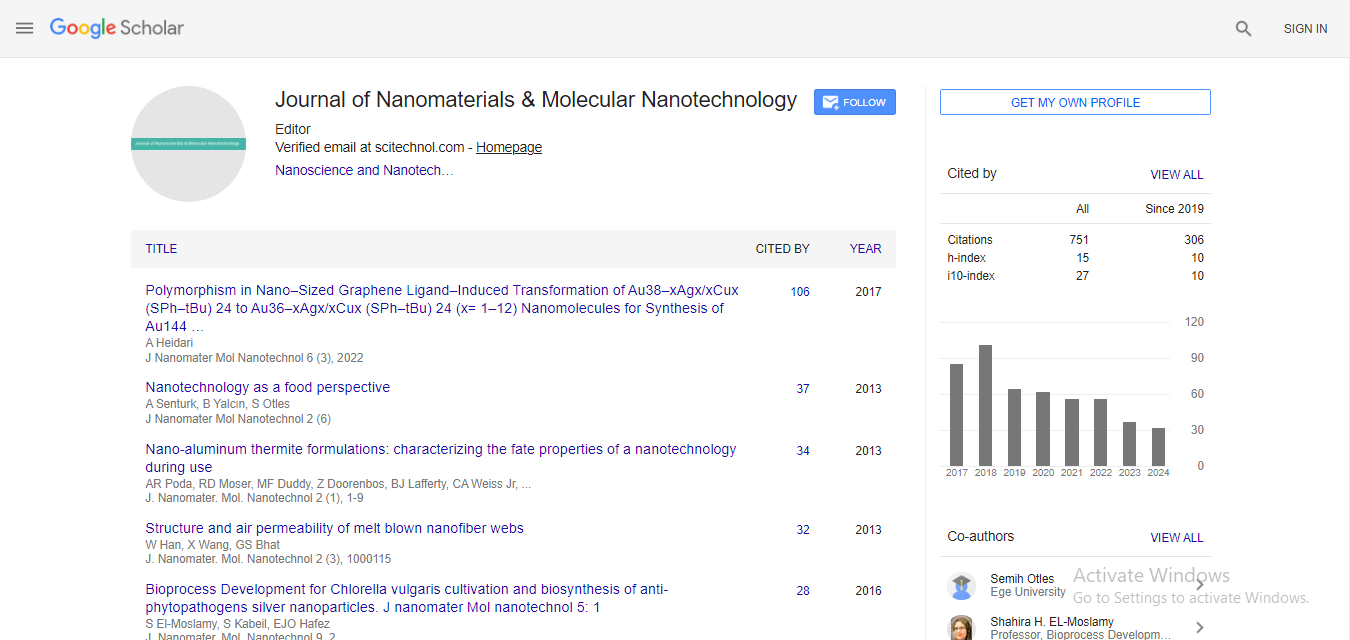Characterization of the solvent specific evaporation from carbon nanotube bucky papers with different functionalization
Ildiko Y Toth, Erzsebet S Bogya, Krisztina A Nagy, Attila Egedy and Akos Kukovecz
University of Szeged, Hungary
University of Pannonia, Hungary
: J Nanomater Mol Nanotechnol
Abstract
Recent developments in nanotechnology have highlighted the importance of the classical topics of wetting, droplet spreading and evaporation due to their pronounced effect in technological applications. Carbon nanotubes (CNTs) can be transformed by filtration into a self-supporting, porous, paper like film (bucky paper). Besides offering a convenient alternative to handle CNTs macroscopically, bucky paper is an interesting porous material on its own right. The main goal of this work was to obtain a more detailed picture of the surface properties namely; wetting and vaporization of the bucky papers prepared from nonfunctionalized CNT (nf-CNT), –COOH functionalized CNT (f-CNT) and their 1:1 mixture (0.5nf-0.5f-CNT). The evaporation of sessile droplets (e.g., water, ethanol, 2-propanol, 1, 4-dioxane, etc.,) was studied by simultaneous weight monitoring, electric resistance measurement and infrared imaging at 50°C. There are several parameters characteristic for the evaporation process, the most important ones being the total evaporation time, time of evaporation only from the surface, full width at half maximum of the time-dependent bucky paper mass and resistance curves, evaporation rate, initial area of the droplet and the wetted area at the moment of total evaporation from the surface. Combined, these represent the evaporation profile. It was proved by using statistical methods (e.g., Pearson correlation coefficients), that the experimentally determined values are specific for the physical properties of the solvents and they are also dependent on the quality of the solid materials therefore, they can be used for qualitative chemical analysis via the estimation of physical properties. The results allow us to presume the possibility of this experimental setup and theoretical approach for a potential future application in the field of analytics. Recent Publications 1. Iijima (1991) Helical microtubules of graphitic carbon. Nature 354:56–58. 2. Halonen et al., (2010) Three-dimensional carbon nanotube scaffolds as particulate filters and catalyst support membranes. ACS Nano 4(4):2003–2008. 3. Kukovecz et al., (2007) Controlling the pore diameter distribution of multi-wall carbon nanotube bucky papers. Carbon 45(8):1696–1698. 4. Schuszter et al., (2015) Liquid droplet evaporation from bucky paper: on the fundamental properties of the evaporation profile. Microporous Mesoporous Materials 209:105–112. 5. Bogya et al., (2016) Surface pinning explains the low heat transfer coefficient between water and a carbon nanotube film. Carbon 100:27–35.
Biography
Ildiko Y Toth is a Postdoc in the Department of Applied and Environmental Chemistry at University of Szeged. Her main research topics are the characterization and tuning of the surface charge and surface energy of nanostructures and the evaporation of different solvents from porous materials. Her PhD work was the synthesis of variable sized magnetite nanoparticles and their surface modification by poly-anionic coatings made at the Aqueous Research Group in University of Szeged.
E-mail: ildiko.toth@chem.u-szeged.hu
 Spanish
Spanish  Chinese
Chinese  Russian
Russian  German
German  French
French  Japanese
Japanese  Portuguese
Portuguese  Hindi
Hindi 



